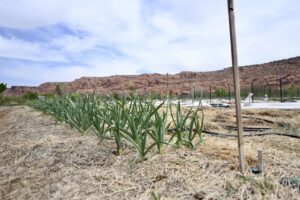Moab is an oasis in the desert, and for some, gardening here is a lifestyle choice. The Moab Sun News chatted with a few of our town’s local gardeners to collect tips for a productive gardening season: find last week’s edition of the Moab Sun News for part one, and follow along next week as we conclude with part three.
Tricia Scott, Moab Garden Club
Tricia Scott runs the Moab Garden Club, a group that meets once a month to share advice and tour local gardens. Gardening in Moab is challenging, Scott said, but extremely rewarding.
Scott recommended that all gardeners understand the microclimates within their gardens and yards: where is the shade, where is the heat, and when are areas shaded or hot? Understanding microclimates can help gardeners plan out how much water their plants will need, she said—shaded areas need less, hot areas need more.
“Using what survives and thrives here is the goal,” Scott said. “Native species for Xeriscaping can help with low water use.”
“Using plants and trees for privacy is wonderful too,” she said. “Trees can hide views that are undesirable, like a neighbor’s hideous garage that remains open constantly. Trees and shrubs can help filter noise as well, and they provide shelter for birds and make your space more defined and attractive. I have used them to create “rooms” we can enjoy outside even on the hottest of days.”
Rhonda Gotway Clyde, Easy Bee Farm
Rhonda Gotway Clyde runs Easy Bee Farm, a farm located in Spanish Valley that offers CSAs (community supported agriculture) and a farmstand where people can buy local produce.
Gotway Clyde’s biggest advice: think of the needs of individual plants.
“Incorporate plants like penstemon, globemallow, and rice grass that attract bees and pollinators to pollinate the vegetable garden and draw in beneficial insects to battle the bad,” she said. If bugs are particularly bad in your garden, she recommends planting around the bug breeding season, waiting until mid-June if necessary to plant certain veggies.
Another aspect of a healthy garden is its plant and soil diversity, Gotway Clyde said. She suggests planting all different kinds of plants in an area—root vegetables, flowers, grasses, and trees—and to focus on the soil by adding compost and mulch.
Kara Dohrenwend, Rim to Rim Restoration and Wildland Scapes
Kara Dohrenwend runs Rim to Rim Restoration, an environmental nonprofit, and Wildland Scapes, a plant nursery and landscape company. Her biggest tips concerned water use: there are ways Moab gardeners can maintain a healthy garden while also conserving the valley’s water.
With landscape plants, such as trees, water deeply but infrequently, Dohrenwend said—trees only need water once per week. While tree shade is amazing, Dohrenwend said gardeners can also use outdoor shade sails in the yard, which can be moved around.
Dohrenwend also recommends designing landscapes based on water needs: plants with similar water use should be placed near each other. She often looks to the University of Utah Extension’s website for gardening tips (extension.usu.edu/yardandgarden/), and recommended gardeners take advantage of that resource.
The last garden advice article will be next week, featuring tips from the Youth Garden Project and Becky Mann of the Resiliency Hub and MoCom Gardens.




